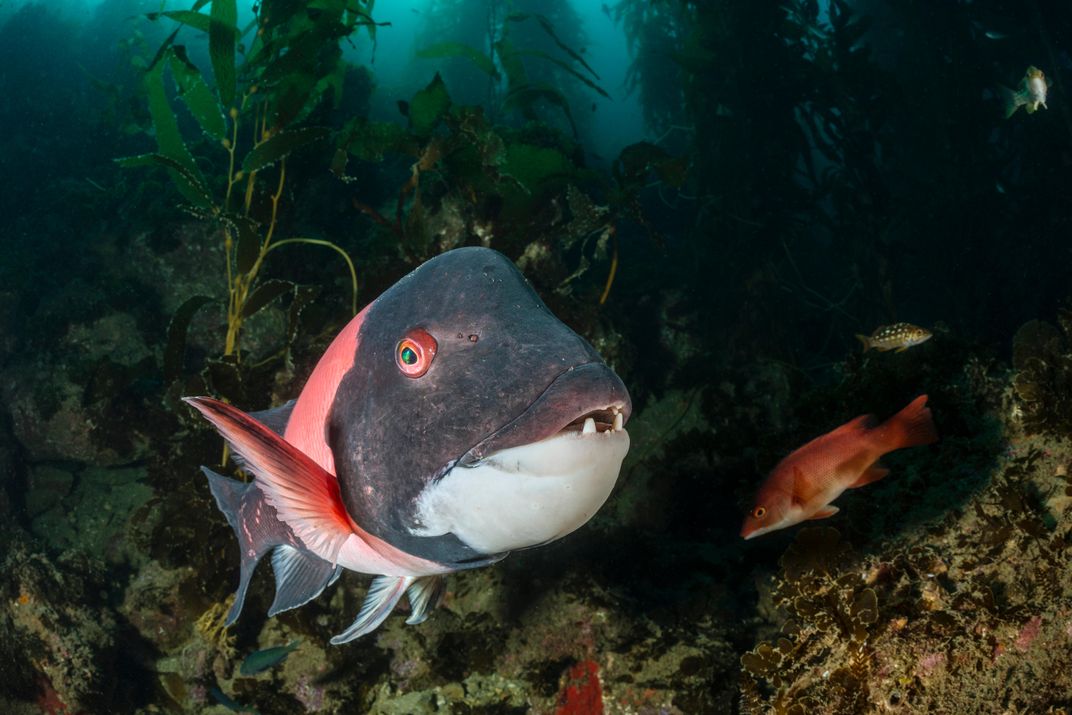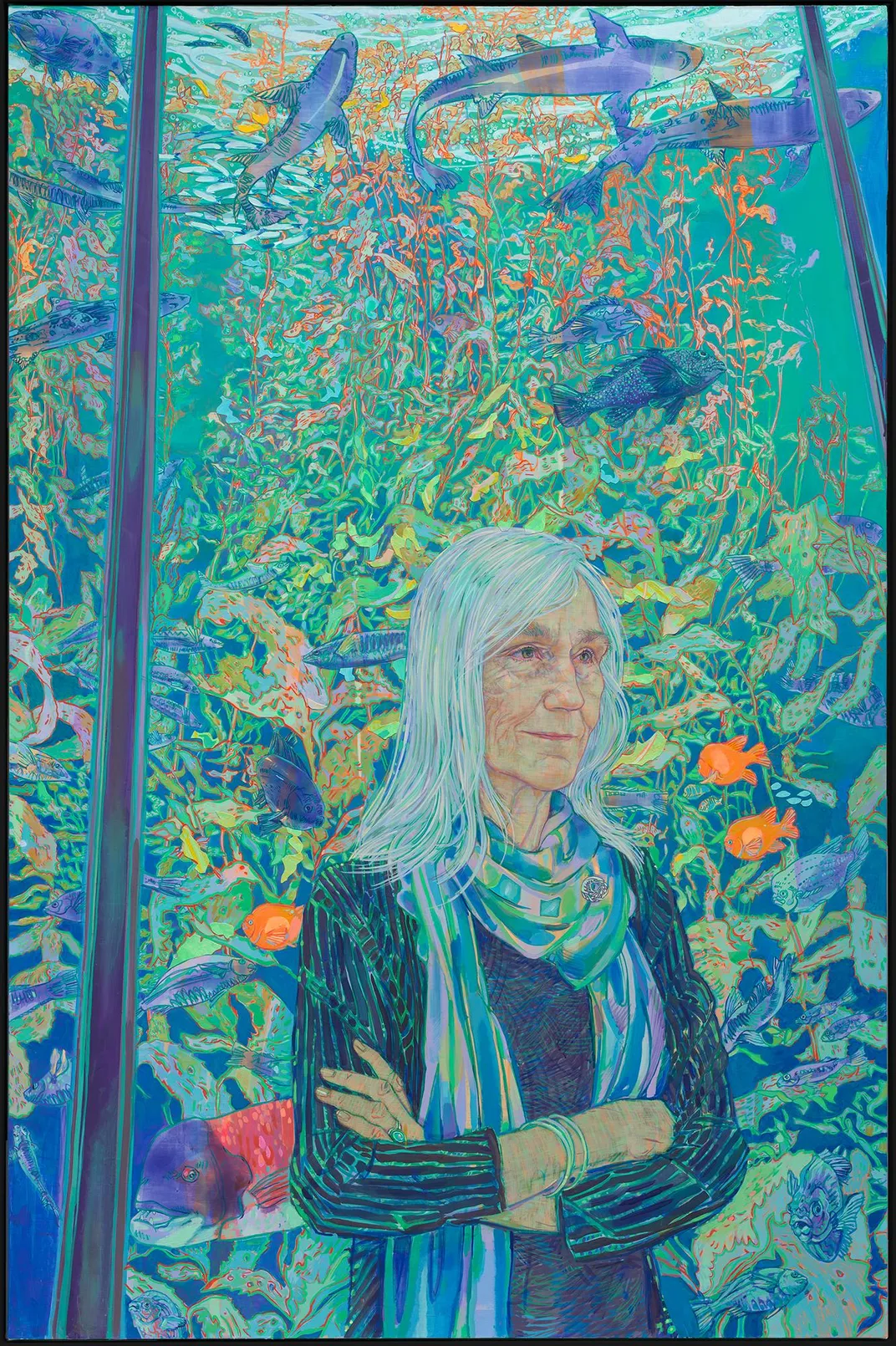Fishes Were Julie Packard’s Wishes for Her New Smithsonian Portrait
National Portrait Gallery unveils a painting honoring the renowned ocean conservationist and director of the Monterey Bay Aquarium
:focal(786x976:787x977)/https://tf-cmsv2-smithsonianmag-media.s3.amazonaws.com/filer/49/c0/49c00a6e-c0d3-4464-98d1-16ce35471572/pa_npg_19_99_packard_t.jpg)
When ocean conservationist Julie Packard was looking over a near-complete version of her likeness, soon to be hung in the Smithsonian’s National Portrait Gallery, she had a request.
“She was inspecting the painting,” says Hope Gangloff, the New York City-based artist commissioned to do the portrait. “She creeps up on it and she’s like, ‘The fish’s teeth need to be much bigger!’”
This wasn’t a matter of looks—in fact, the oversize chompers on a California sheephead (Semicossyphus pulcher) are a little unsettling. But Packard, the founding executive director of the Monterey Bay Aquarium, wanted her portrait to accurately highlight the marine creatures to which she has dedicated her life’s work. That meant giving the sheephead the big teeth it uses to munch on crabs and urchins.
Packard has been leading the aquarium since its 1984 opening, where she’s made it her mission to engage the public in ocean conservation through exhibits and education initiatives. She received the Audubon Medal for Conservation in 1998, and in 2009 was elected a Fellow of the American Academy of Arts and Sciences.

Her portrait, which is being unveiled today at the National Portrait Gallery, is the result of months of sessions, a cross-country road trip and the Smithsonian American Women’s History Initiative, a five-year project to recognize the contributions of women in American society. The painting will be one of only a few portraits in the gallery that honors ocean conservationists, and Packard is only the second woman featured in that field after ecologist and writer Rachel Carson.
Though Packard says she wasn’t too keen on all the personal attention, she saw the portrait as an opportunity to highlight the aquarium and its mission. She was determined to have the ocean feature as a central part of the painting—so Packard requested that the portrait be set in the aquarium itself, a place she says has its own form of artistry.
“An aquarium is essentially a living museum,” she says. “There’s a lot of art in nature, and we really focus on the aesthetic and visual power of our living collection.”
Specifically, Packard wanted to highlight one of the aquarium’s “Kelp Forest,” a towering central tank in which silvery-bronze leopard sharks, pouty cabezon and sleek, shiny sardines dart through gently waving seaweed fronds. The display was considered a big risk at first, Packard says, as no one had ever preserved a living kelp forest out of the ocean before. It has since grown into one of the aquarium’s signature features—it’s still the largest kelp forest living outside of the wild, and is a main attraction for the aquarium’s nearly two million annual visitors.

To best portray that setting, Gangloff drove out west to meet Packard in Monterey. She says she was “blown away” by the aquarium (the San Francisco Chronicle has dubbed it the “city’s crown jewel” and a “scientific and policy powerhouse”) and spent about a week there, exploring the exhibits and studying the marine life that would make up the background of her painting. Gangloff also invested hours sitting with Packard every day to portray her human subject with the same precision.
“[Packard] is extremely optimistic and reminds us that we have to be that way in order to get anything done,” Gangloff says. “I wanted to capture her combination of optimism, very serious drive and calmness.”
After the excursion, Gangloff returned to New York with a slew of small canvases and papers. She spent the next few months piecing together these fragments into a final composition on a much bigger scale—the portrait measures 54- by 81-inches. Packard later visited the artist’s Chelsea studio for one final sitting; last-minute touch-ups included bigger teeth for the sheephead and messier hair for Packard, both in the name of accuracy.
The finished product is a vibrant work awash with blue tones and full of movement. True to life, every creature in the scene can be found in the aquarium’s kelp forest, Gangloff says, from the sleek leopard sharks gliding near the top to the bright orange garibaldi darting across the center. Packard says she’s pleased with how the painting captures the essence of the aquarium and the “explosion of color” visitors experience while walking through the exhibits.
The work will remain on display at the National Portrait Gallery through November 2020. “The history of portraiture has favored men from the ruling elite, and as a result less than a quarter of our collection depicts women who tend to come from professions ‘in the public eye’ such as politicians, actors and authors,” says the museum's director Kim Sajet. “But scientists, especially women scientists, have historically been relegated to the background of achievement—and art. We felt it was important to commission a new work of a leader in education, research, and activism—who could serve as an inspiration to young girls in particular.”
Packard says she’s excited to help represent the diverse collection of people who contribute to the sciences, and hopefully inspire others to pursue careers in conservation. Despite national efforts to engage a wider variety of students in science fields, Packard says there’s still a major drop-off through middle and high school of girls pursuing science—a discrepancy she says needs to change, for the good of our natural world.
“We need all the talent and all the passion that we can gather to solve the environmental problems that are facing us today,” she says, “and that will become even more serious on into the future.”
Julie Packard by Hope Gangloff is on display on the first floor of the National Portrait Gallery through November 2020.
/https://tf-cmsv2-smithsonianmag-media.s3.amazonaws.com/accounts/headshot/Maddie_3.jpg)


/https://tf-cmsv2-smithsonianmag-media.s3.amazonaws.com/accounts/headshot/Maddie_3.jpg)